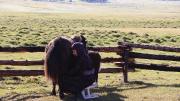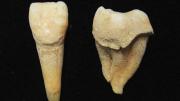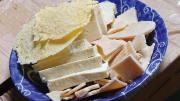When the sons and grandsons of Genghis Khan ruled the Mongol empire in the thirteenth century, it stretched from eastern Europe to the Pacific Ocean, and encompassed Persia in the south and Russia to the north. How did this nomadic culture—the third such empire to rise from the arid grasslands of the Eurasian Steppe since 200 b.c.—conquer and cohere across such vast distances? And how did these nomads’ predecessors, pastoralists with ox-drawn carts, spread swiftly east and west to forever change the genetic structure of Europe and Asia?
Answers have been hard to come by, in part because nomadic cultures leave only limited archaeological evidence of their lifeways behind—mortuary mounds with occasional animal-bone offerings are the prime archaeological feature of the Eastern Steppe. Now a scientist interested in reconstructing ancient diets and understanding the evolution of the human microbiome has begun to assemble new types of evidence suggesting that the ability to build a succession of empires on the Eurasian Steppe has been predicated, at least in part, on dairying: the widespread production and consumption of horse, sheep, goat, cow, and other milks and milk products that sustained and tied nomadic tribes together culturally across vast distances. And the record showing the origin, extent, and diversity of this custom lies in a durable and extraordinarily representative source: ancient dental plaque.
“Dental calculus is fascinating because it’s like the kitchen sink—a time capsule of your mouth and everything that goes into it,” says assistant professor of anthropology Christina Warinner, who is also a Seaver assistant professor at the Radcliffe Institute. Ancient tartar, once discarded, is now regarded by archaeologists as a vital archive that preserves individuals’ DNA, their oral microbiome, and traces of what they ate—all thanks to Warinner, who first began exploring its potential while a Harvard graduate student. In 2014, she and her colleagues showed that milk proteins can become trapped in calcifying human dental plaque, enabling researchers to determine when livestock milk first began appearing in human diets. In addition, the specific amino acid sequences of the recovered milk proteins act as a kind of fingerprint that can reveal which livestock species were being milked.
Warinner is using plaque analysis, together with “a little genetics, a bit of microbiology, history, social archaeology, and ethnography” to pursue a larger goal: understanding the origins and global spread of dairying. “How did we end up with this crazy food that adult humans aren’t meant to digest,” she asks, “and how have we made it work?” Dairying, well-studied in Western European cultures, was once thought to have spread alongside a genetic mutation that makes it possible to digest lactose, a milk sugar, into adulthood. This correlation between culture and a genetic trait, driven by natural selection, appears to have been the dominant pattern for dairying’s spread in the British Isles and Scandinavia, where a majority of people now carry the gene variant. But most of the world’s population—including the nomads of the Eurasian Steppe—lack such a mutation. Warinner’s work nevertheless provides direct evidence that this did not hinder the rapid adoption of domesticated milk production in that region.
In new research described in Nature Ecology & Evolution, Warinner and her coauthors use dental calculus to show that around 3000 b.c., ruminant dairying rapidly spread thousands of kilometers across the Eurasian Steppe, from the north Caucusus region near the Black Sea to as far east as Mongolia, in the span of only a few centuries. There, the grasslands, although inhospitable to grain agriculture, provided abundant nutrition for grazing animals and supported the production of a wide variety of dairy-based foods for humans.
But not until 1200 b.c., coincident with the first plaque-protein evidence for horse-milk consumption, does mobile pastoralism “reach its height,” says Warinner. Mare’s milk was probably used “almost exclusively for alcohol production,” to make a drink that is still used today to cement contracts and social ties, but the use of horses led to a transformative expansion of dairying culture. Horses travel farther and faster than other ruminants, she points out, thereby enhancing herding capacity, access to pasturage, and the control of larger territories. And in winter, they dig instinctually for snow-covered grasses, exposing it for sheep, goats, and cattle, which would otherwise starve. “Horses,” explains Warinner, “made the whole dairy-based economy work better and more efficiently.” The stage was set for the rise of nomadic empires.
But at least one mystery remains. Although 95 percent of the Eastern Steppe population lacks the gene variant for digesting lactose, ethnographic studies of modern nomadic herders show that between 30 percent and 50 percent of their summertime dietary calories come from dairy products. These range from mare’s milk (men will consume up to eight liters of fermented airag a day), to lightweight, calorie-dense curds that can be transported and stored for up to two years—in all, more than 20 different dairy-based foods. How these nomads cope with such extreme levels of lactose in their diet is unknown, but Warinner suspects they may have highly altered gut microbiomes that could be adaptive. This summer, she is beginning to test that hypothesis, working remotely from Cambridge with her field collection team in COVID-free Mongolia. She just might find that the Mongol empire was built on milk and microbes.











